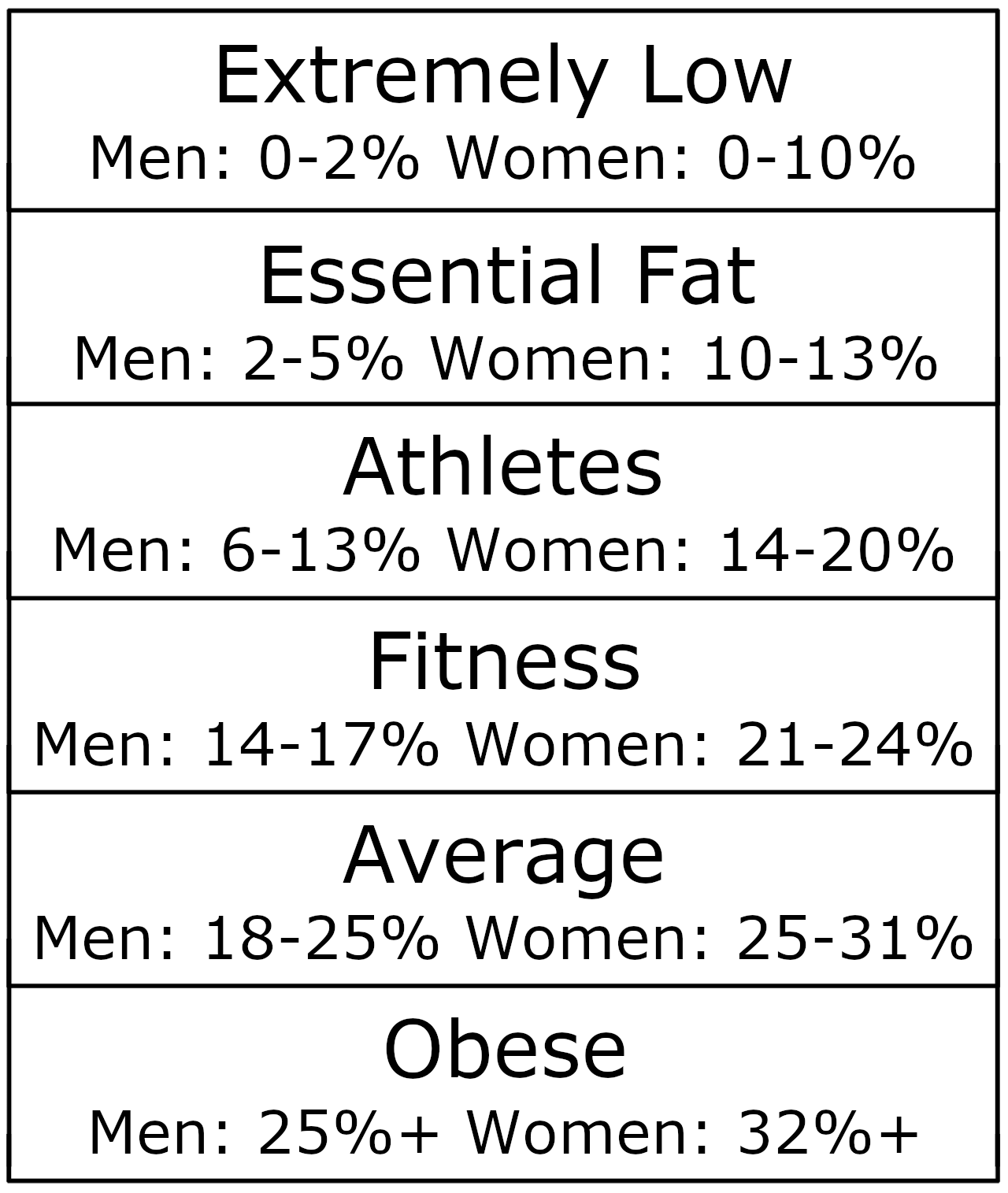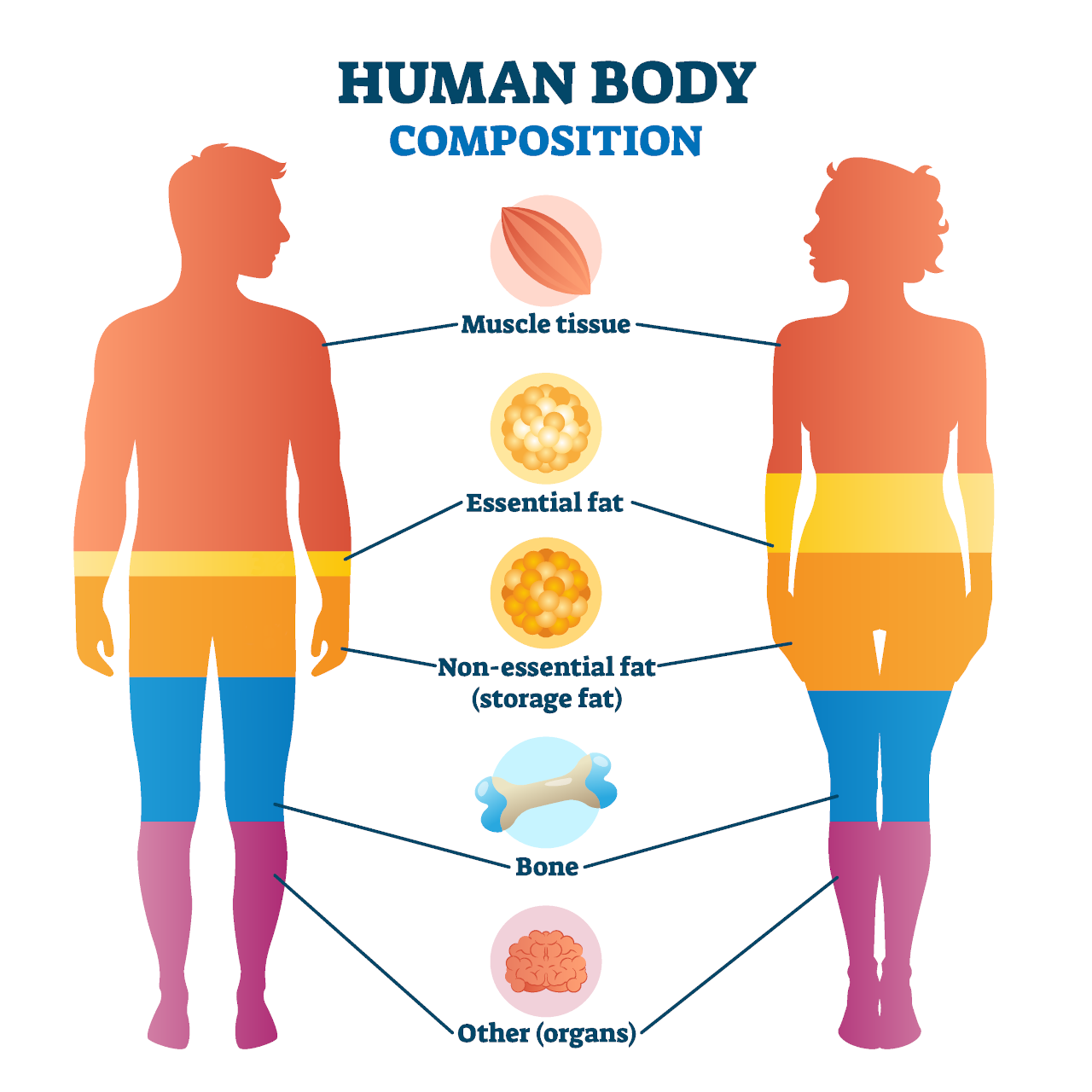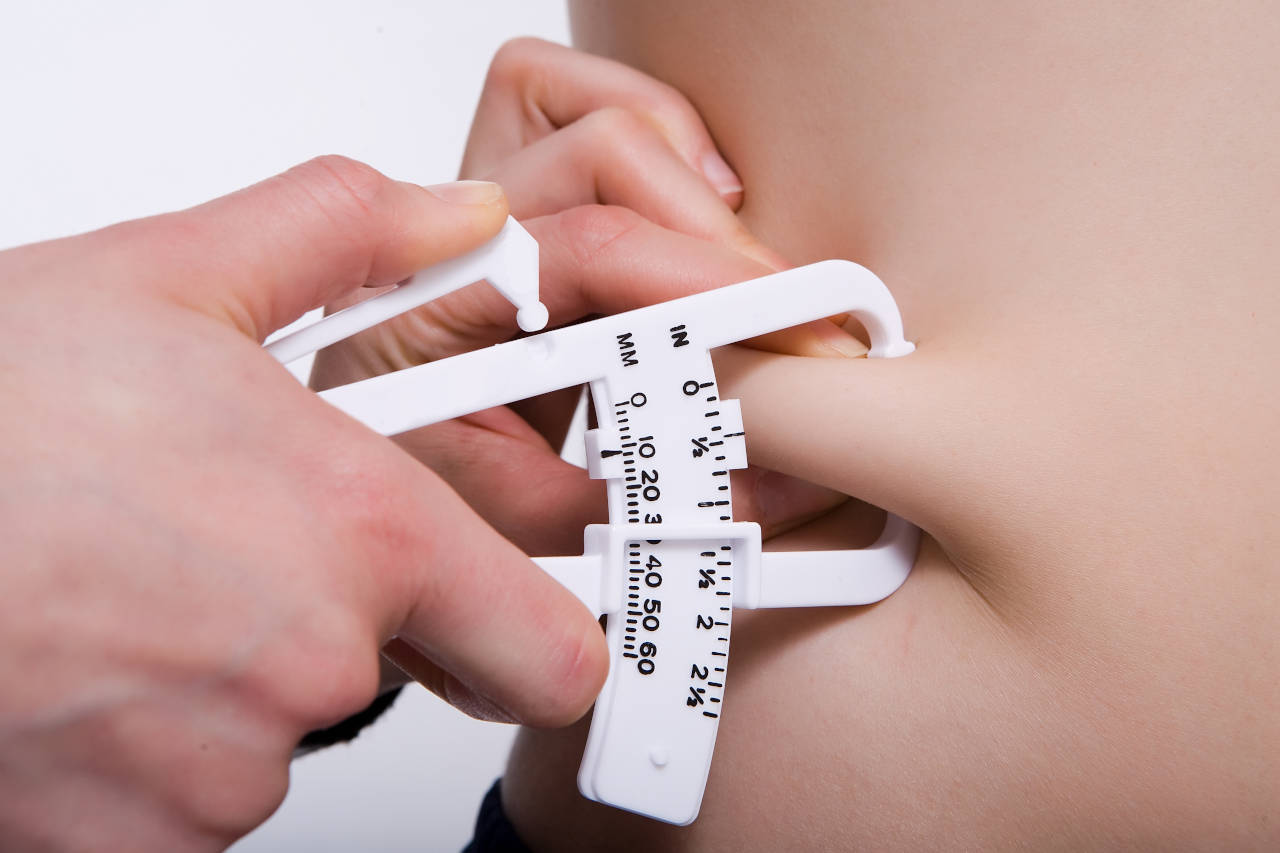Body Fat Calculator
Choose one of the five methods below to calculate your body fat percentage.
Estimate your body fat percentage using your calculated BMI and standard body measurements.
Estimate your body fat percentage using the U.S. Navy method, which uses neck, waist, and hip circumference measurements.
Estimate your body fat percentage using the Jackson & Pollock 3-site skinfold method, which uses three measurements taken with skinfold calipers.
Estimate your body fat percentage using the Jackson & Pollock 4-site skinfold method, which uses four measurements taken with skinfold calipers.
Estimate your body fat percentage using the Jackson & Pollock 7-site skinfold method, which uses seven measurements taken with skinfold calipers.
Results:
| Body fat percentage: | %
|
| Body fat category: | |
| Calculated BMI: | |
| Body fat weight: | lb
|
| Lean body mass: | lb
|

On this page:
- Calculator
- How to Calculate Body Fat
- Why is Body Fat Percentage Important?
- How to Measure Body Fat Percentage
- U.S. Navy/Army Body Fat Method
- BMI Body Fat Method
- The Accuracy of the BMI Method
- Skinfold Method (3, 4, & 7-Site Jackson & Pollock methods)
- How to Measure Skinfolds
- Specialized Equipment to Measure Body Fat
- How Much Body Fat Should You Have?
- How Much Body Fat Do You Have?
- References
How to Calculate Body Fat
Health and body weight are closely tied together. However, your percentage of body fat is just as much, if not more important, than body weight alone.
This is because body fat, not just body weight, is associated with chronic health issues such as heart disease, diabetes, hypertension, and even some types of cancers. In fact, studies have found that individuals with a normal BMI but a high body fat percentage are at an increased risk for prediabetes and type 2 diabetes.[2]
This makes sense from a practical standpoint. An athlete that weighs 180 pounds with 20% body fat and a high amount of lean muscle is much healthier than someone who weighs 180 pounds but is sedentary and has 40% body fat.
There are a number of ways to determine body fat. This includes direct measurement in a medical setting as well as measurements that can be done at home.
Why is Body Fat Percentage Important?
First, it is important to understand what body fat percentage means. Determining your total body composition takes into account your lean muscle mass, body fat percentage, bone mass, and water weight.

Research has found that body fat percentage is a better indicator of obesity-related health conditions such as coronary heart disease risk than waist circumference.[3] Higher levels of body fat also have a stronger association with cardiovascular disease risk and mortality when compared to BMI.[4]
Another study from the European Heart Journal found that individuals with high amounts of body fat but normal weight, as reported by BMI, still had a high prevalence of cardiometabolic dysregulation, metabolic syndrome, and CV risk factors.[5] This makes maintaining a healthy body fat percentage extremely important.
How to Measure Body Fat Percentage
Body fat is generally measured as a percentage of body weight. There are several different methods used to determine body fat, and each has its own benefits and drawbacks.
U.S. Navy/Army Body Fat Method
The U.S. Navy/Army body fat formula only requires you to measure your waist and neck circumference. This can then be used in a formula to determine your body fat percentage.
The benefit of this method is that it only requires a tape measure, so it is cheap and quick to do from home.
While it is not as accurate as direct measurements such as a DXA scan, studies have shown the error rate to still be relatively low, around 2.5-5%. This is still more accurate than many bioelectrical impedance methods.
To measure waist circumference, wrap the tape measure around the narrowest part of your waist. This is midway between your bottom rib and top of the hip bone, right around the navel.
For neck circumference, measure right above the Adam’s apple.
For women, hip circumference is also used. The measuring tape should be placed around the hips so that it passes over the greatest protrusion of the hips as viewed from the side.
These numbers can then be used in the following equation:
U.S. Navy Body Fat Formula
Men:
body fat = [86.010 × log10(waist – neck)] – [70.041 × log10(height)] + 36.76
Women:
body fat = [163.205 × log10(waist + hip – neck)] – [97.684 × log10(height)] – 78.387
A recent 2019 study found that this formula had slightly higher values for both muscle mass and body fat ratio in both genders and across all BMI categories when compared to bioelectrical impedance.
However, the differences were not statistically significant, illustrating that these are both fairly reliable ways to estimate body fat percentage.[6]
Since this is a rather complicated formula, it can be much easier to plug your measurements into a body fat calculator instead.
BMI Body Fat Method
Body mass index, or BMI, is widely used to estimate body fat based on height and weight.
BMI Formula
Metric Units
BMI = weight [kg] / height² [m²]
Imperial Units
BMI = weight [lb] / height² [in²] × 703
Once you figure out your BMI, this can then be used in the formula below to calculate your body fat percentage. Unlike BMI, these formulas are different based on gender.
BMI Body Fat Formula
Men:
body fat = (1.20 × BMI) + (0.23 × age) – 16.2
Women:
body fat = (1.20 × BMI) + (0.23 × age) – 5.4
BMI can also be used as a predictive formula if you are trying to figure out your ideal body weight. A 2016 study found that you can use a target BMI to compute ideal body weight.[7]
This would then allow you to plug that BMI into the equation to not only determine an ideal weight, but also an ideal body fat percentage.
IBW [lb] = 5 × BMI + ((BMI ÷ 5) × (height − 60 [in]))
The Accuracy of the BMI Method
While the BMI method allows you to get a number using a simple formula and easy measurements, since it only takes height and weight into consideration, it is not an accurate model for all individuals.
It’s important to note that this method does not actually measure body fat at all and is merely an estimate with known limitations.[8]
For instance, some individuals may have a higher body weight due to increased lean muscle mass rather than fat mass.
Using the BMI method as a measurement of body fat may falsely suggest that they have more body fat and are overweight or obese. Therefore, you should consider individual circumstances when using body mass index calculations to measure body fat and consider a more precise method of measuring it.
Skinfold Method (3, 4, & 7-Site Jackson & Pollock methods)
Another at-home method that is affordable and relatively reliable is using a body fat caliper to measure skinfold thickness. These measurements are then used in different body fat equations depending on how many areas of the body you measure.
For the three-site method, the areas measured are different for males and females.
Male
- Chest
- Abdomen
- Thigh
Female
- Triceps
- Suprailium
- Thigh
The four-site method is the same for males and females and requires measurements of the triceps, suprailium, abdominal, and thigh areas.
In the seven-site method, the areas measured are the same for both men and women.
- Triceps
- Chest/Pectoral
- Midaxillary
- Subscapular
- Suprailiac
- Abdominal
- Thigh
How to Measure Skinfolds
The trickiest part of using body fat calipers is ensuring that you measure the correct area and pinch the appropriate amount of fat. This takes practice and should be done several times to ensure consistent results.
You will need to pinch the skin into a fold and then place the calipers around the skinfold to get your final measurement.

| Site | How To Measure |
|---|---|
| Triceps | Vertical measurement at the midpoint of the triceps between shoulder and elbow with arm relaxed at the side. |
| Chest | Diagonal measurement halfway between the anterior axillary (armpit) line and the nipple. |
| Subscapular | Diagonal fold approximately 2 centimeters from the inferior angle of the scapula. |
| Midaxillary | Midaxillary line horizontal to xiphoid process of the sternum. |
| Suprailiac | Diagonal fold parallel and above the iliac crest. |
| Abdominal | Vertical or horizontal fold 2 centimeters to the right of the navel. |
| Thigh | Midpoint vertical fold of the front side of the upper leg between the patella (kneecap) and top of thigh. |
One of the drawbacks of using skinfold thickness is that it can be difficult to properly measure the correct amount of fat. You may need help from someone in measuring and recording the numbers, especially for more hard-to-reach spots on your body.
Once you have your skinfold measurements, you can then plug these into either the 3, 4, or 7-site skinfold thickness calculator to determine your estimated body fat percentage.
The error range varies, although some studies have found error rates ranging from an overprediction of 10% to an underprediction of over 15%.[9] However, ensuring that you are consistent with your measurements can aid you in tracking your body fat percentage over time to at least monitor trends in loss or gain of body fat.
These calculations are rather complicated and differ between men and women, which makes using an automated calculator the easiest means to calculate body fat percentage when using the skinfold method.
The skinfold thickness of each site is first used to compute body density. These numbers are then used to determine body fat percentage. If you prefer to do the math yourself, the equations are as follows:
3-Site Body Fat Percentage Formula
Men:
Pectoral, Abdominal, and Thigh thickness in millimeters:
body density = 1.10938 – (0.0008267 × sum of skinfolds) + (0.0000016 × (sum of skinfolds)²) – (0.0002574 × age)
Women:
Triceps, Suprailiac, and Thigh thickness in millimeters:
body density = 1.0994921 – (0.0009929 × sum of skinfolds) + (0.0000023 × (sum of skinfolds)²) – (0.0001392 × age)
body fat = (495 ÷ body density) – 450
4-Site Body Fat Percentage Formula
Men:
Abdominal, Triceps, Thigh, and Suprailiac thickness in millimeters
body density = (0.29288 × sum of skinfolds) – (0.0005 × (sum of skinfolds)²) + (0.15845 × age) – 5.76377
Women:
Abdominal, Triceps, Thigh, and Suprailiac thickness in millimeters
body density = (0.29669 × sum of skinfolds) – (0.00043 × (sum of skinfolds)²) + (0.02963 × age) + 1.4072
body fat = (495 ÷ body density) – 450
7-Site Body Fat Percentage Formula
Men:
Chest, Axila, Triceps, Subscapular, Abdominal, Suprailiac, and Thigh thickness in millimeters
body density = 1.112 – (0.00043499 × sum of skinfolds) + (0.00000055 × (sum of skinfolds)²) – (0.00028826 × age)
Women:
Chest, Axila, Triceps, Subscapular, Abdominal, Suprailiac, and Thigh thickness in millimeters
body density = 1.097 – (0.00046971 × sum of skinfolds) + (0.00000056 × (sum of skinfolds)²) – (0.00012828 × age)
body fat = (495 ÷ body density) – 450
Specialized Equipment to Measure Body Fat
There are several methods for measuring body fat using specialized equipment, and they cannot be done at home.
Underwater Weighing
Underwater weighing used to be the gold standard for determining body fat percentage. Since muscle and bone are more dense and fat is more buoyant, someone with a higher body fat will weigh less underwater.
Using this principle, a person is first weighed on dry land. Next, they sit on a special scale as they are submerged underwater and asked to exhale all the air from their lungs and stay motionless while their weight is measured.
This procedure is repeated three times and averaged. A special calculation is then used to determine lean weight and fat weight and determine the percentage of body fat.[10]
DEXA Scan
A DEXA scan, also sometimes abbreviated DXA, is short for dual X-Ray absorptiometry.
A DEXA scan is often associated with determining someone’s bone mineral density; however, it also measures all components of your body composition. It works by sending a low x-ray beam that calculates soft tissue and bone density.
The DEXA scan then provides you with an analysis of your body composition based on the density of your fat, muscle, and bone.
Bod Pod
A Bod Pod is an egg-shaped piece of equipment that measures your body volume and the volume of gas contained within your chest to determine your body density. This then calculates your percentage of body fat and lean body mass.
Bioelectrical Impedance
Bioelectric impedance is a widely available method for use at home or the gym to determine body fat percentage. These machines require you to stand (and sometimes hold) onto electrodes that use a low-voltage electric current to assess body composition.
However, these scales are less accurate than other methods and still use calculations based on age, sex, and height to compute body fat percentage. Studies have found that bioelectrical impedance data is actually of lower quality than waist circumference or BMI for detecting metabolic risk factors (4) and can have an error rate of up to 8%.[11]
How Much Body Fat Should You Have?
After you calculate your body fat, you can then compare the percentage to the chart for healthy body fat percentages. This will differ between males and females. According to the American Council on Exercise, body fat categories are as follows:
| Men | Women | |
|---|---|---|
| Essential Fat | 10-13% | 2-5% |
| Athletes | 14-20% | 6-13% |
| Fitness | 21-24% | 14-17% |
| Average | 25-31% | 18-25% |
| Obese | >32% | 25% |
Normal Body Fat Percentage For Men vs. Women
There are clear differences in what constitutes a healthy body fat range depending on if you are male or female. This is due to the fact that there is a certain fat percentage that is required for basic physiologic functions.
Body fat is also dependent on genetics, body shape, and hormone fluctuations. Since women require more body fat for bearing children, they naturally have higher amounts to serve as essential fat.
For a group of people with the same BMI, women typically present with roughly 10% higher body fat compared to men, which accounts for the differences in body fat percentages that are considered healthy in men and women.[12]
You can use a fat intake calculator to find how much fat your body actually needs as part of your diet to maintain a healthy weight or for weight loss.
How Much Body Fat Do You Have?
As you can see, there are a number of different methods to calculate your body fat percentage. At this time, the most accurate appears to be DEXA scanning, as this gives you an actual measurement of fat, bone, and lean muscle tissue by using an X-ray scanner.
Underwater testing may be quite accurate as well but it is estimated that 46% of the population fear the deep end of the pool, and 2-3% have a fear of water.[13]
However, most people do not have access to high-tech machines underwater testing and and need a way to not only measure their body fat, but also to continually monitor body composition trends over time. The above formulas provide affordable and easy ways to achieve this.
By keeping track of your body fat percentage, you can ensure that you are maintaining not only a healthy weight, but also a healthy total body composition.
Similar Health Calculators
References
- The American Council on Exercise, What are the guidelines for percentage of body fat loss?, https://www.acefitness.org/resources/everyone/blog/112/what-are-the-guidelines-for-percentage-of-body-fat-loss/
- Gómez‐Ambrosi, J., Silva, C., Galofré, J. C., Escalada, J., Santos, S., Gil, M. J., Valentí, V., Rotellar, F., Ramírez, B., Salvador, J., & Frühbeck, G., Body adiposity and type 2 diabetes: increased risk with a high body fat percentage even having a normal BMI, Obesity, 2011, 19(7), 1439-1444. https://onlinelibrary.wiley.com/doi/full/10.1038/oby.2011.36
- Dervaux, N., Megnien, J. L., Chironi, G., & Simon, A., Comparative associations of adiposity measures with cardiometabolic risk burden in asymptomatic subjects, Atherosclerosis, 2008, 201(2), 413-417. https://www.sciencedirect.com/science/article/abs/pii/S0021915007007629
- Romero-Corral, A., Somers, V. K., Sierra-Johnson, J., Korenfeld, Y., Boarin, S., Korinek, J., Jensen, M., Parati, G., & Lopez-Jimenez, F., Normal weight obesity: a risk factor for cardiometabolic dysregulation and cardiovascular mortality, European heart journal, 2010, 31(6), 737-746. https://pubmed.ncbi.nlm.nih.gov/19933515/
- Hemmingsson, E., Uddén, J., & Neovius, M., No apparent progress in bioelectrical impedance accuracy: validation against metabolic risk and DXA, Obesity, 2009, 17(1), 183-187. https://pubmed.ncbi.nlm.nih.gov/18997678/
- Shaheen, A., Javed, N., Azam, F., Liaquat, A., Khan, M., Alam, S. M., & Mumtaz, S., Comparison of bioelectrical impedance and navy seal formula to measure body composition in medical students, Cureus, 2019, 11(5), https://www.ncbi.nlm.nih.gov/pmc/articles/PMC6650177/
- Peterson, C. M., Thomas, D. M., Blackburn, G. L., & Heymsfield, S. B., Universal equation for estimating ideal body weight and body weight at any BMI, The American journal of clinical nutrition, 2016, 103(5), 1197-1203. https://pubmed.ncbi.nlm.nih.gov/27030535/
- Prentice, A. M., & Jebb, S. A., Beyond body mass index, Obesity reviews, 2001, 2(3), 141-147. https://onlinelibrary.wiley.com/doi/abs/10.1046/j.1467-789x.2001.00031.x
- Peterson, M. J., Czerwinski, S. A., & Siervogel, R. M., Development and validation of skinfold-thickness prediction equations with a 4-compartment model, The American journal of clinical nutrition, 2003, 77(5), 1186-1191. https://pubmed.ncbi.nlm.nih.gov/12716670/
- Quinn, E., How to Measure Body Fat With Hydrostatic Underwater Weighing, Verywell Fit, https://www.verywellfit.com/what-is-hydrostatic-underwater-weighing-3120276
- Lichtenbelt, W. D. V. M., Hartgens, F., Vollaard, N. B., Ebbing, S., & Kuipers, H., Body composition changes in bodybuilders: a method comparison, Med Sci Sports Exerc, 2004, 36, 490-497. https://www.researchgate.net/profile/Wouter-Van-Marken-Lichtenbelt/publication/12083275_Comparison_of_body_composition_methods_A_literature_analysis/links/5a041d054585151f47908ab6/Comparison-of-body-composition-methods-A-literature-analysis.pdf
- Karastergiou, K., Smith, S. R., Greenberg, A. S., & Fried, S. K., Sex differences in human adipose tissues - the biology of pear shape, Biology of sex differences, 2012, 3(1), 13. https://doi.org/10.1186/2042-6410-3-13
- Cleveland Clinic, Aquaphobia (Fear of Water), https://my.clevelandclinic.org/health/diseases/22958-aquaphobia-fear-of-water



